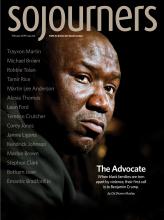IN THE SPAN OF OUR HOUR-LONG conversation, Mimi Mutesa, an emerging Ugandan-American photographer-videographer and an undergraduate student at Calvin College, a Christian Reformed school in Michigan, easily gives her thoughts on everything from the complexities of blackness to the policing of women’s bodies. However, when I ask her how her faith influences her work, there is a brief pause on the other end of the line.
“I don’t think it’s ever crossed my mind until this moment,” she says. When pressed, she explains that she’s “trying to tackle enough issues” in her art as it is, and evangelical culture has “far too many other problems” for her to address. Mutesa assures me that she still identifies as a person of faith but maintains that her relationship with God is “separate” from her relationship to art and social justice.
Perhaps this separation is a necessary one. It’s hard to imagine the average evangelical church embracing Mutesa’s colorful portraits of nude black joy. Her sentiments echo an unspoken opinion held by many young Christians, that if you want to be radical like Jesus was, you must do so on the margins of Christianity. More traditional folks may see this rush to the margins as a slick avoidance of the Christian call to profess one’s faith, or a symptom of postmodern discomfort with absolute truth. But what is more likely is that millennials of faith, especially millennials of color, want to engage with values traditionally cherished by the church but see modern-day Christianity as a direct hindrance to that sort of exploration, since significant portions of the church have been antagonists in struggles for social equality.
Reticence to conflate personal faith with artistic vision is deeply connected to a complex historical dialectic between the arts and the church: Mutesa’s midconversational pause is supported by precedent.
Read the Full Article

